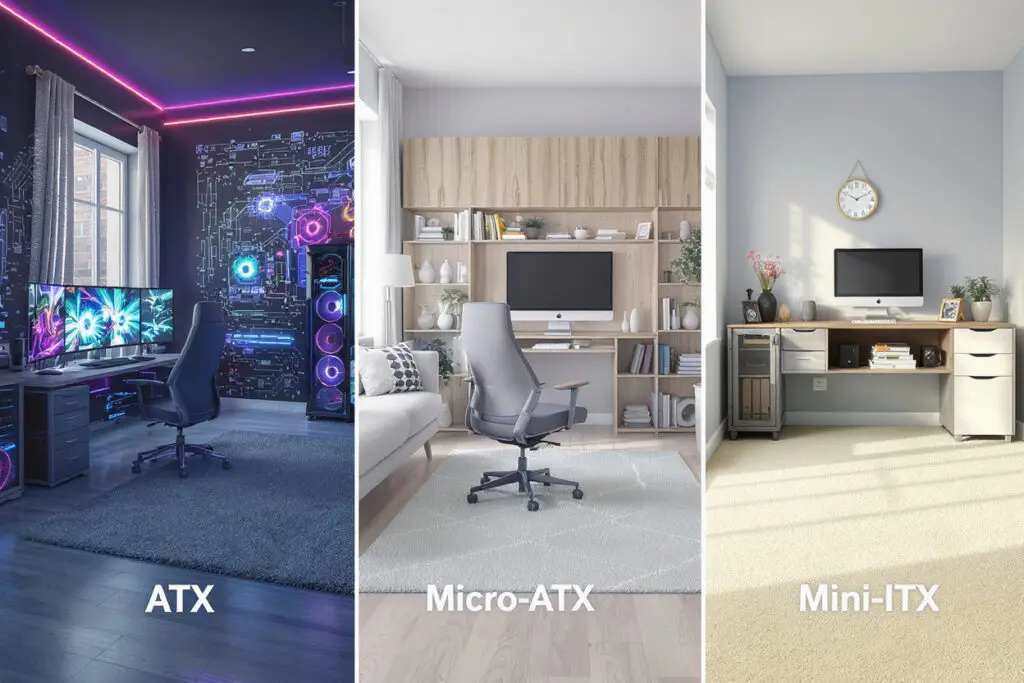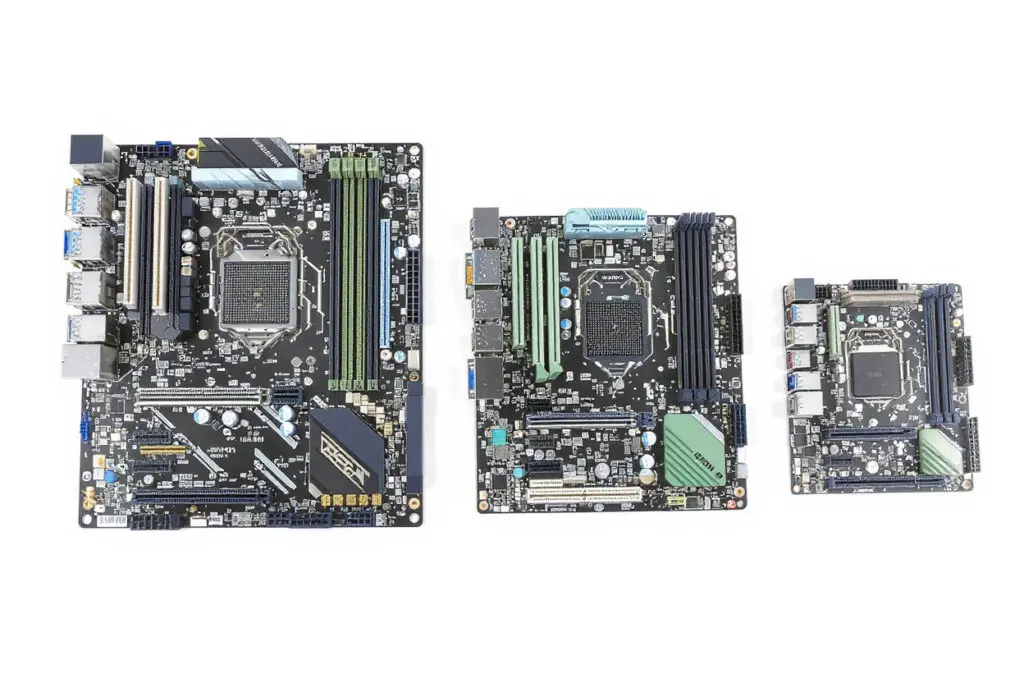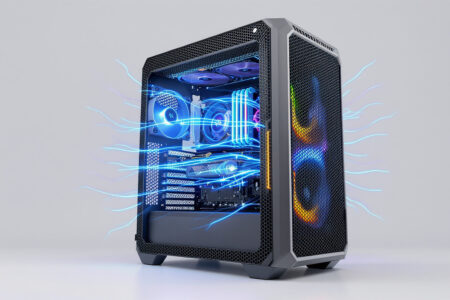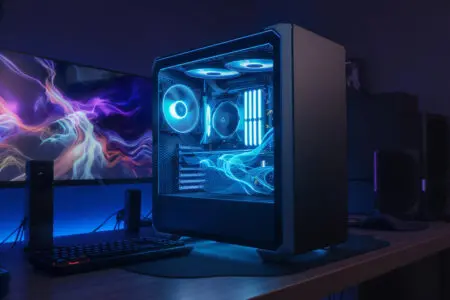Jumping into the world of PC building is a special kind of thrill. It’s a whole process of learning, discovering, and, finally, creating something with your own two hands. You’re not just buying a machine; you’re building your machine. But before you get to the fun stuff—like slotting in a massive graphics card or a top-tier processor—you have to make one big decision first. It’s a choice that shapes everything that comes after, from the size of your rig to what you can do with it down the road. I’m talking about the big debate over motherboard sizes: ATX vs. Micro-ATX vs. Mini-ITX.
I remember that feeling like it was yesterday. Years ago, I was sitting on my floor, surrounded by a sea of cardboard boxes. The sheer size of my first ATX motherboard was both awesome and terrifying. Did I make the right call? It felt massive. Was this overkill? Or was it the perfect starting point for a total beginner? This article is the guide I wish I’d had back then. We’re going to cut through the jargon, lay out the real-world pros and cons of each size, and help you pick the perfect foundation for your dream PC. This isn’t about numbers on a spec sheet. It’s about finding what truly fits your desk, your budget, and your goals.
More in Hardware Category
The Best PC Case Fan Setup for Airflow
How Many Case Fans Do I Need For a Gaming PC
Key Takeaways
- ATX (Advanced Technology eXtended): The full-sized original. Go with ATX if you want the most room for expansion cards (like multiple GPUs), the smoothest building experience, and the biggest feature sets. It’s the top choice for monster gaming rigs, workstations, or anyone who wants zero regrets about future upgrades.
- Micro-ATX (mATX): The versatile middle child. Micro-ATX nails the balance between size and features, often for a better price. It has plenty of slots for what most people, including most gamers, actually need. Plus, it fits in smaller, more convenient cases. It’s the “just right” pick for many.
- Mini-ITX (mITX): The small form factor specialist. Choose Mini-ITX only if your number one priority is building the smallest, most space-saving PC possible. Just be ready for a trickier build, careful part-picking, and sometimes higher costs for those specialized components. It’s the undisputed king of minimalist setups and portable LAN party machines.
So, What Exactly Are These “Form Factors” Anyway?
Before we get into the showdown, we need to be clear on what we’re talking about. When you hear “form factor,” you probably just think about how big the motherboard is. You’re not wrong—that’s a huge part of it. But it goes a little deeper. Don’t think of it like small, medium, and large t-shirts. Think of it more like the chassis blueprint for a car.
A motherboard form factor is really a standard. It defines the board’s exact dimensions, where the screw holes go (so it actually fits in the case), the layout of the ports on the back, and even the type of power connectors it uses. This standardization is the secret sauce that lets you buy a case from NZXT, a motherboard from ASUS, and know that they’ll play nicely together.
Is it Just About the Size?
When you get down to it, the most obvious difference is the physical size. A standard ATX board is 12 by 9.6 inches. A Micro-ATX is a tidy 9.6-inch square, and a Mini-ITX is a tiny 6.7-inch square. But that size difference is a direct result of the features a board can hold. The decision you’re making isn’t just about physical space; it’s about what you can plug into your motherboard.
Here’s the one rule you can’t break: your case has to be big enough for your motherboard. You can almost always put a smaller board in a bigger case (like a Micro-ATX board in an ATX case), but you can’t magically shrink a big board to fit in a small case. It’s simple physics. That’s why choosing your form factor is the very first domino you have to push.
Let’s Talk About the Big Kahuna: The ATX Standard
When you imagine a classic gaming PC—a big, powerful tower lit up and humming away—you’re probably thinking of an ATX build. Intel introduced it way back in 1995, and ever since, ATX has been the king of the hill for custom PCs. It’s the benchmark, offering the most space, the most features, and, for a lot of builders, the most peace of mind.
For years, it was just what you got if you were serious about building a powerful computer. The huge layout gives manufacturers tons of room to add beefy power delivery for overclocking, more ports, and other cool features. For you, the builder, all that space just makes the whole process easier and less stressful.
Why Do So Many Builders Swear by ATX?
There’s a good reason ATX is still the favorite for hardcore enthusiasts. It all comes down to expansion. ATX boards can have up to seven PCIe slots. Now, most gamers will only ever use the main one for their graphics card. But having those extra slots opens up a lot of doors. Want a dedicated sound card for making music? A capture card for your Twitch stream? Multiple GPUs for 3D rendering? ATX is the only size that says, “Sure, no problem.”
I can still feel the heft of my very first motherboard. It was an ATX board, and as I pulled it out of the anti-static bag, it felt like a piece of sci-fi armor. As a nervous first-timer, that size was a lifesaver. I had so much room to maneuver. I could route cables without a struggle, install the giant CPU cooler without busting my knuckles, and click the RAM in without feeling like I was performing surgery. That forgiving experience is what made me fall in love with building. And that extra space isn’t just for beginners; it also means better airflow, which helps keep your parts cool, quiet, and running at their best.
But Is Bigger Always Better?
Of course not. The greatest strength of ATX is also its biggest flaw: it’s huge. An ATX tower takes up a serious amount of space, whether it’s on your desk or hiding underneath it. If you live in a dorm, a small apartment, or just hate clutter, a full-tower PC can feel like an unwelcome roommate.
On top of that, you pay for all those extra features. ATX motherboards and the big cases they need are usually more expensive than their smaller relatives. You have to ask yourself, “Am I actually going to use all this stuff?” If you just want to play games with a single graphics card, you’re paying a premium for a bunch of empty slots and a lot of dead air inside your case. For a lot of people today, ATX is just plain overkill.
Finding the Sweet Spot: Could Micro-ATX Be Your Goldilocks?
If ATX is the big, do-everything SUV and Mini-ITX is the tiny, zippy sports car, then Micro-ATX is the perfect hatchback. It’s practical, it’s efficient, and it can do more than you’d think. It really hits that sweet spot that makes it the smartest choice for a huge number of PC builders today. It trims the fat from the ATX standard without forcing you to make the big sacrifices that come with Mini-ITX.
Micro-ATX (or mATX) basically just lops off the bottom section of an ATX board. That one change leads to a bunch of good things: a smaller footprint, lower prices, and more case options that don’t look ridiculous in a normal room.
What Do You Give Up by Going a Little Smaller?
The main thing you lose with Micro-ATX is a few PCIe expansion slots. Ana Little Smaller?
The prima whilery sacrifice you make when choosing That might sound like a huge downgrade, but let’s be real. The average PC user, even a serious gamer,sounds like a cuts be realistic about mode takes upsage. Theority of gamers and general That still leaves you with one or two free slots for things like a Wi-Fi card if you need one.and probablythe one builders, that’s plenty.
You’re not losing out on much else. Most mATX boards still have four RAM slots, just like their ATX big brothers, so you can pack innough.
You rarely And you’re not sacrificing power, either. giv can find mATX boards with high-end chipsets and great power delivery, ready to handle the fastest CPUs you can throw at them.. You also don’t necessarily sacrifice performance; high-end chipsets and robust power delivery systems are readily available on mATX motherboards, making them fully capable of handling top-tier CPUs and intense overclocking.
What’s the Real-World Advantage of Micro-ATX?
The benefits are immediate and practical. First, cost. Both mATX motherboards and cases are consistently cheaper than their ATX equivalents, freeing up more of your budget for the components that directly impact performance, like the GPU and CPU. Second, size. A Micro-ATX case is noticeably more compact. It’s easier to transport, fits comfortably on a desk without dominating the space, and offers a cleaner, less imposing look.
I saw this firsthand a few years back. My brother was heading off to college and needed a powerful PC for his engineering coursework that could also handle some serious gaming. His dorm room desk was tiny; a massive ATX tower was completely out of the question. We built a system around a Micro-ATX board. It was the perfect compromise.
The build was still straightforward, it had all the power he needed, and the compact tower left him with enough desk space for his textbooks. It was a potent, practical machine that proved you don’t need a giant case to get giant performance. It’s this blend of value, capability, and manageable size that makes Micro-ATX the champion for so many builders.
The Art of the Tiny PC: Diving into the World of Mini-ITX
Welcome to the deep end of the pool. Mini-ITX is where PC building transforms from a straightforward assembly process into a fascinating, three-dimensional puzzle. It’s a world of incredible power density, where every single millimeter matters. These builds, often called Small Form Factor (SFF) PCs, are a testament to modern engineering, packing the punch of a high-end desktop into a chassis that’s often no bigger than a gaming console or a shoebox.
Choosing Mini-ITX isn’t just a practical decision; it’s a philosophical one. It’s for the builder who values elegance, efficiency, and the challenge of creating something incredibly potent in a tiny package. But this path is not for the faint of heart. It demands patience, meticulous planning, and a willingness to embrace a unique set of challenges.
How Can Something So Small Be So Powerful?
The Mini-ITX standard is ruthlessly efficient. It provides the absolute essentials and nothing more: two RAM slots and a single PCIe x16 slot. That’s it. There’s no room for extra expansion cards or extravagant feature sets. Every component on the board is placed with surgical precision to maximize space.
This minimalist approach is possible because modern technology has integrated so many features directly into the CPU and motherboard chipset. High-speed Wi-Fi, premium audio, and multiple M.2 slots for lightning-fast NVMe SSDs are now common on Mini-ITX boards. This means you can build a complete, top-tier gaming system using only that single PCIe slot for your graphics card. The result is a clean, uncluttered, and unbelievably compact machine.
What’s the Catch with Building a Mini-ITX PC?
The rewards of a finished Mini-ITX build are immense, but the journey is fraught with peril for the unprepared. The challenges are significant:
- Space & Building Difficulty: This is the big one. Working inside a cramped Mini-ITX case is an order of magnitude harder than in an ATX tower. Cable management isn’t just for looks; it’s critical for airflow and is often the most difficult part of the build. Your hands will feel clumsy and huge.
- Component Compatibility: You can’t just buy any component and expect it to fit. CPU cooler height, graphics card length and thickness, and power supply type (many cases require a smaller SFX unit) must all be checked and double-checked against your case’s specifications.
- Thermals & Airflow: Heat is the enemy of performance, and in a tiny, cramped case, it’s a constant battle. SFF cases rely on clever design and the strategic placement of fans to exhaust hot air. Poor component choice or sloppy cable management can quickly create a hotbox that throttles your expensive hardware.
- Cost: Ironically, shrinking down can cost you more. High-quality, well-engineered Mini-ITX cases and motherboards often carry a premium price tag due to the specialized design and manufacturing required.
My most recent personal project was a Mini-ITX build for my living room, designed to replace a console. It was, without a doubt, the most demanding, frustrating, and ultimately satisfying build of my life. I spent more time researching component dimensions on forums and watching build guides for that specific case than I did on the actual assembly. I must have re-seated the CPU cooler three times to get it oriented perfectly for airflow. But when it was finished, and I held that dense, heavy little cube of silent power in my hands, it was a feeling of pure triumph.
How Do I Actually Choose Between ATX vs. Micro-ATX vs. Mini-ITX?
Alright, we’ve covered the technical details and the philosophies behind each size. Now it’s time to get personal. The truth is, there is no single “best” form factor. The right choice is entirely dependent on you: your budget, your goals, your available space, and your tolerance for a challenge. Let’s break down the decision-making process into the questions you should be asking yourself.
Does Your Budget Make the Decision For You?
For many, this is the starting point. While there are exceptions at the very high end, a general cost hierarchy exists. If you are building on a tight budget, Micro-ATX is your undisputed champion. The motherboards and cases offer the best bang-for-your-buck, allowing you to allocate more money toward the parts that directly influence your frame rates.
ATX typically occupies the mid-range to high-end of the price spectrum. You’re paying a bit more for the larger board, more features, and the bigger case. At the top of the pricing pyramid, you’ll often find premium Mini-ITX and high-end ATX boards competing. The specialized engineering of a feature-packed Mini-ITX board and the boutique cases designed for them can easily cost more than a comparable ATX setup. Don’t assume smaller automatically means cheaper.
What Will You Actually Use Your PC For?
Be honest with yourself about your use case. This is the most important factor.
- You’re a Power User or Content Creator: Do you work with 4K video, run complex simulations, or need to install specialized hardware like capture cards or 10-gigabit networking adapters? If you need more than just a single graphics card, your choice is made for you. Go with ATX. The flexibility afforded by its numerous expansion slots is non-negotiable for your workflow.
- You’re a Dedicated Gamer: Your goal is to get the best gaming performance possible for your money. You need one powerful graphics card, good cooling, and enough RAM. You have no plans for a second GPU or other expansion cards. For you, Micro-ATX is the smartest choice. It provides everything you need without the extra cost and physical bulk of ATX. Of course, a standard ATX build is also a fantastic option if you prefer an easier building experience and have the space for it.
- You’re a Space-Conscious Minimalist or Traveler: Is your desk space limited? Do you move frequently or want to take your PC to LAN parties or a friend’s house? Is the aesthetic of a small, unobtrusive machine appealing to you? If you answered yes to any of these, then you are the ideal candidate for a Mini-ITX build. You’re willing to accept the challenges and potential extra cost in exchange for an incredibly compact form factor.
How Much Do You Care About Aesthetics and Desk Space?
Never underestimate the visual and environmental impact of your PC. A full-tower ATX case is a statement. It’s a monolith of power that can be a stunning centerpiece in a dedicated gaming room. It says, “I am serious about performance.” But in a multi-use living space or a small office, it can be an overbearing presence.
A Micro-ATX build offers a more restrained look, fitting neatly into most environments. A Mini-ITX build, on the other hand, can be a magic trick. A sleek SFF case can sit on your desk next to your monitor and look like a stylish accessory, or tuck away on a media stand and be completely unnoticed until its power is unleashed. The final decision is a blend of the practical and the personal.
What Are Some Common Pitfalls to Avoid?
Navigating the ATX vs. Micro-ATX vs. Mini-ITX landscape is exciting, but there are a few common traps that new and even experienced builders can fall into. Keeping these in mind can save you a world of headache and potential buyer’s remorse.
- Ignoring Component Dimensions (Especially for mITX): This is the cardinal sin of small form factor building. Don’t just assume your giant air cooler or triple-slot, 320mm long graphics card will fit. You must read the specifications for your chosen case and verify the maximum clearance for every single component.
- The “Empty House” Syndrome: Putting a tiny Mini-ITX or even a Micro-ATX motherboard inside a massive full-tower ATX case. While it will technically work, it often looks awkward with vast seas of empty space. It also negates the entire point of choosing a smaller board, wasting space and often resulting in less-than-optimal airflow patterns.
- Forgetting About Airflow: Just because a case has fan mounts doesn’t mean it has good airflow. This is especially true for smaller cases. Pay attention to how air is designed to enter and exit the chassis. A case with a choked-off front panel, for example, will struggle to cool high-performance components regardless of its size.
- Skimping on the Power Supply: When choosing a small form factor case, you’ll often need a specific type of power supply unit (PSU), usually an SFX or SFX-L model. Don’t just buy the cheapest one. A quality PSU is critical for system stability, especially in a power-dense, heat-sensitive Mini-ITX build.
Beyond the Big Three: Are There Other Sizes I Should Know About?
While ATX, Micro-ATX, and Mini-ITX make up over 99% of the consumer PC market, it’s worth knowing that the family tree does have a few other branches, mostly for the ultra-niche enthusiast. You might occasionally see references to E-ATX (Extended ATX), which are even wider than standard ATX boards to accommodate more hardcore features for server-grade hardware and extreme overclocking. On the other end of the spectrum, you have formats like the Thin Mini-ITX, designed for building incredibly slim all-in-one style PCs.
For the vast majority of people reading this, these are fascinating footnotes rather than practical considerations. Understanding the core trade-offs between the main three is the key. For those curious about the deep engineering history and specifications, the resources at a university’s computer science department can offer a glimpse into the standards that shape our hardware. For example, a look into the computer hardware guides from Tom’s Hardware can provide exhaustive detail on these specifications.
Your Build, Your Choice
Choosing a form factor is the first real step in defining the personality of your new PC. There’s no right or wrong answer, only what’s right for you. Don’t let anyone tell you that you must have an ATX tower for serious gaming, or that Mini-ITX is too difficult for a new builder. If you do your research and plan carefully, any path is achievable.
Think of it this way: ATX offers a world of possibilities. Micro-ATX offers a world of practicality. Mini-ITX offers a world of personality. Reflect on your space, your budget, and what truly excites you. No matter which size you choose, the journey of bringing your creation to life is one of the most rewarding experiences in technology. So plan carefully, ask questions, and build something you are truly proud of.
FAQ – ATX vs. Micro-ATX vs. Mini-ITX

How should I decide between ATX, Micro-ATX, and Mini-ITX for my build?
Deciding depends on your budget, availability of space, and your specific needs. If you want maximum expandability and easier building, ATX is ideal. If space and cost are concerns, Micro-ATX offers a practical compromise. For portability and minimalist setups, Mini-ITX is the best choice.
What makes Mini-ITX suitable for small form factor PCs?
Mini-ITX is designed for building very compact, space-saving PCs. It features minimal slots and ports, focusing on efficiency and power density, which allows high-performance builds in small, portable cases, but requires careful component selection and planning.
Why is ATX considered the standard for high-end gaming and workstation builds?
ATX is favored because it offers the most space for multiple expansion cards, more ports, and better cooling options. Its larger size provides more room for features and easier building, making it ideal for powerful, expandable systems.
What are the benefits of choosing Micro-ATX over ATX?
Micro-ATX provides a good balance between size and features, offering sufficient expansion slots, lower cost, and more compact cases. It’s practical for tight spaces without sacrificing performance or upgradeability for most users.
What are the main differences between ATX, Micro-ATX, and Mini-ITX motherboards?
The primary differences are their physical sizes, with ATX being the largest, Micro-ATX in the middle, and Mini-ITX the smallest. These sizes determine the number of expansion slots, ports, and features available, and also influence the size of the case needed for the build.





